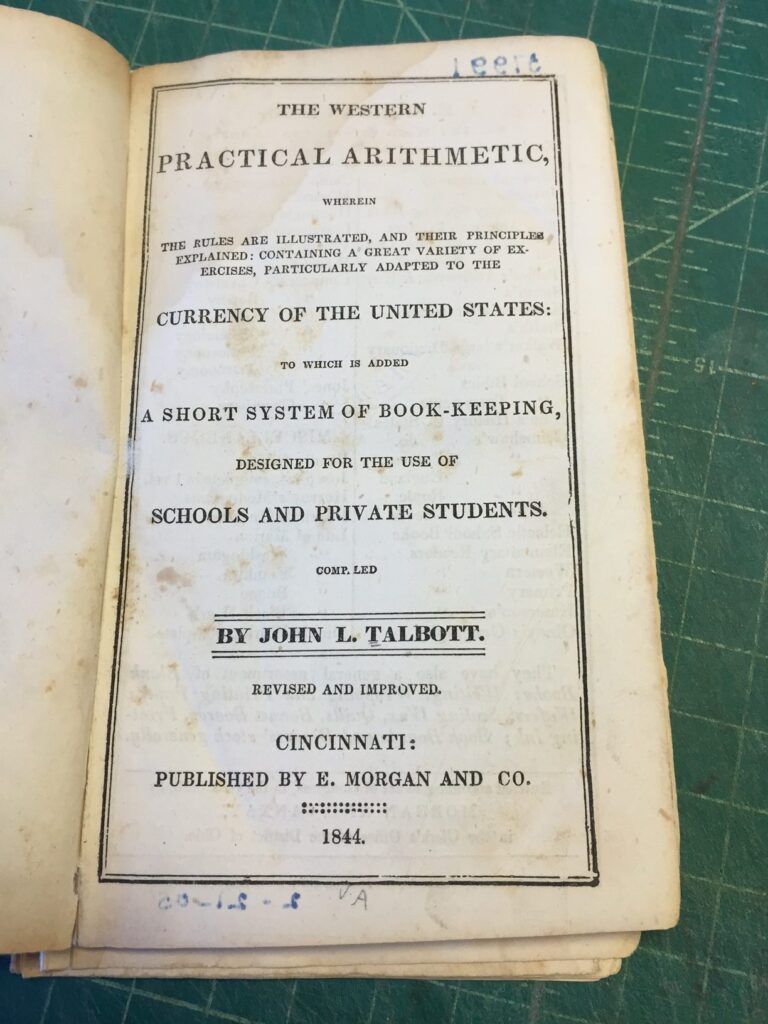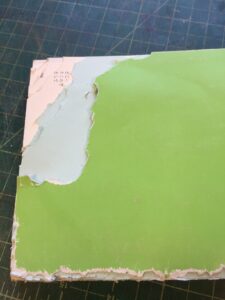Recently, I was repairing this book:

I have a fondness for old textbooks, so it was nice to have a chance to help this one out. It was a pretty straightforward repair. Some hinging of pages and a reback with a Japanese tissue/linen laminate. But here’s the thing that really grabbed me about the book. It smelled of wood smoke. Not that familiar, musty, foxed, sat-in-the-stacks for 100 years smell. Fireplace smell.
I realize that the smell is probably because this little book survived the IU Library fires in 1969. You can read a nice history of those two fires, as well as other significant IU campus fires in a recent blog post from the IU archive. At the lab, we often see books with their top page edges blackened, and we generally assume that they are survivors from the 1969 fires. But this nicely smelling book didn’t make me think of destruction and student unrest. I grew up in a house that was heated with a wood stove. It smelled like home. Or like the house of a friend where sometimes we sit by the fireplace and read poetry. And I imagined young people in the late 1800s sitting at a table by the fireplace working studiously on their arithmetic lessons.
There are so many ways that books connect and transport us. Mostly, we think of being transported by the stories they tell. But with a bit of imagination, books can also bring us into contact with the craftspeople who made them, the people who owned and handled them, and sometimes, the rodents who chewed them up.

Sigh. I probably still have mouse DNA on my hands from that one….
In the General Collections Conservation unit, we don’t come across many very old books, but every now and then one will stumble into the lab. In the last months, we’ve had a couple of these that were just hanging out in the stacks waiting for someone to care about them. One is dated 1592. The other is from 1638.

I’m a Bloomington native, so every now and then someone in my family will stop by the lab to drop off homemade bread or pick up a bag of potholders or something. Elise is always happy to show off the amazing things she is working on and my Mom happened to come by on the day she was working on the book shown above. My mother was duly and volubly impressed and that evening I got a call from my Dad. Might he please come in and see the very old book as well? Of course! We love to share the coolness.
Dad showed up the next day. He took a lot of pictures and asked a lot of questions. We even let him hold the book, although like many lab guests, he was a little afraid to do so. I felt like I could see right through his skull into his brain where all of the tumblers and gears were whirring and clicking along. We went out to lunch and talked about how old items connect us to the past. What can we learn about artists and craftspeople by holding their work in our hands? Someone spent hours upon hours of time setting the elaborate type for the book. And who was it that stitched it together? Treated the leather for the cover? How many young people sat at a table by the fireplace studying it? How many fires has it survived?
At about the same time that my father and I were thinking about peoples’ relations to very old books, it seems that my favorite web cartoonist, Randall Munroe, creator of xkcd.com had also been thinking about peoples’ relations to more modern inanimate objects:

How often do we really think about the design of our water glass? How often did the child studying that arithmetic book think about its binding? Probably, not often at all. Perhaps never. Yet, now, we here in the Preservation Lab are fascinated with the old arithmetic book, and of course the older, and therefore more precious books as well. In 172 years, someone will probably be fascinated with our water glasses. And our e-readers.
I was pretty certain that my poet father was going to end up writing something about very old books. And he is far more eloquent than I am, so I waited to see what would come of my dad meeting that book and by extension all of the people who, step by step, brought it to us here.
Old Book
VIRGILII EVANGELISANTIS
CHRISTIADOS
Libri XIII
Londini . 1638Wood and leather cover
brown and brittle,
the scrolled details
faded and blurred,
burnished by the years.
Stiff, when I opened it.Though I could not read
the Latin text,
pressed with movable type
nearly 400 years before,
the words
are clear and elegant,
speaking of a god
of another time.
A palpable spirit emanates
from its enduring lines–thoughts and beliefs
from ambitious minds,
the faith of someone
who reached me
with ethereal touch
from the small book
that rested on my hand.Remnants of those ancient lives,
saved,
but neglected on a secluded shelf,
travelled slowly, unsteady…
still waiting to be found
by some curious stranger
who can read
the relic words.Though the bodies of the writers
are gone,
the lives of their thoughts
live on,
in that old book…Poem copyright Thomas Tokarski, July 2016
3 Comments
I enjoyed this post, which reflects how I feel about books: often humble but still cool and valued.
A lovely post, Lara. Your Dad is a fine poet, and you are a graceful and descriptive writer.athis made my day so much more enjoyable!
Great post Lara!